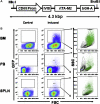Inducible transgenes under the control of the hCD68 promoter identifies mouse macrophages with a distribution that differs from the F4/80 - and CSF-1R-expressing populations
- PMID: 19772887
- PMCID: PMC2925267
- DOI: 10.1016/j.exphem.2009.09.003
Inducible transgenes under the control of the hCD68 promoter identifies mouse macrophages with a distribution that differs from the F4/80 - and CSF-1R-expressing populations
Abstract
Objective: Macrophages are critical components of diverse microenvironments (ME) in adulthood, as well as during embryogenesis. Their role in development precludes the use of gene-targeting and knockout approaches for studying their function. Hence, we proposed to create a macrophage-specific inducible transgenic mouse where genes can be turned on or off at will.
Materials and methods: A transgenic mouse in which the reverse tetracycline activator (rtTA-M2) is expressed under the hCD68 promoter for macrophage-specific gene induction was developed and crossed with a second transgenic reporter mouse strain in which the gene for green fluorescent protein (GFP) is under the control of tetracycline responsive element promoter. After doxycycline induction of the double transgenic animals (designated CD68-rtTA-tet-GFP), inducible expression of GFP was characterized by multicolor flow cytometric analysis of blood, marrow, and spleen cells and by demonstration of GFP expression in fresh-frozen sections in diverse tissues.
Results: In bone marrow, inducible GFP expression was not confined to, or inclusive of, all cells expressing the classical macrophage markers, such as F4/80. However, GFP-expressing cells in thioglycollate-elicited peritoneal macrophages were also positive for F4/80 and monocyte-macrophage-specific 2 antigen. Interestingly, flow analysis also indicated little overlap between the F4/80 and CSF-1R-positive populations. Fresh-frozen samples of tissues known to contain macrophages revealed GFP-expressing cells with variable morphologies.
Conclusion: Our results show that the hCD68 promoter directs gene expression in a macrophage population distinct from that defined by classical monocyte-macrophage markers or promoters. Whether this population is functionally distinct remains to be established.
Figures



References
-
- Laskin DL, Weinberger B, Laskin JD. Functional heterogeneity in liver and lung macrophages (Review). J. Leukoc. Biol. 2001;70:163–170. - PubMed
-
- Zhu Z, Zheng T, Lee CG, Homer RJ, Elias JA. Tetracycline-controlled transcriptional regulation systems: advances and application in transgenic animal modeling (Review). Seminars in Cell and Developmental Biology. 2002;13:121–128. - PubMed
-
- Sasmono RT, Oceandy D, Pollard JW, et al. A macrophage colony-stimulating factor receptor-green fluorescent protein transgene is expressed throughout the mononuclear phagocyte system of the mouse. Blood. 2003;101:1155–1163. - PubMed
-
-
Dziennis S, van Etten RA, Pahl HL, et al. The CD11b promoter directs high-level expression of reporter genes in macrophages in transgenic mice. Blood. 1995;85:319–329. [erratum appears in Blood 1995 Apr 1;85(7):1983].
-
Publication types
MeSH terms
Substances
Grants and funding
LinkOut - more resources
Full Text Sources
Molecular Biology Databases
Research Materials

